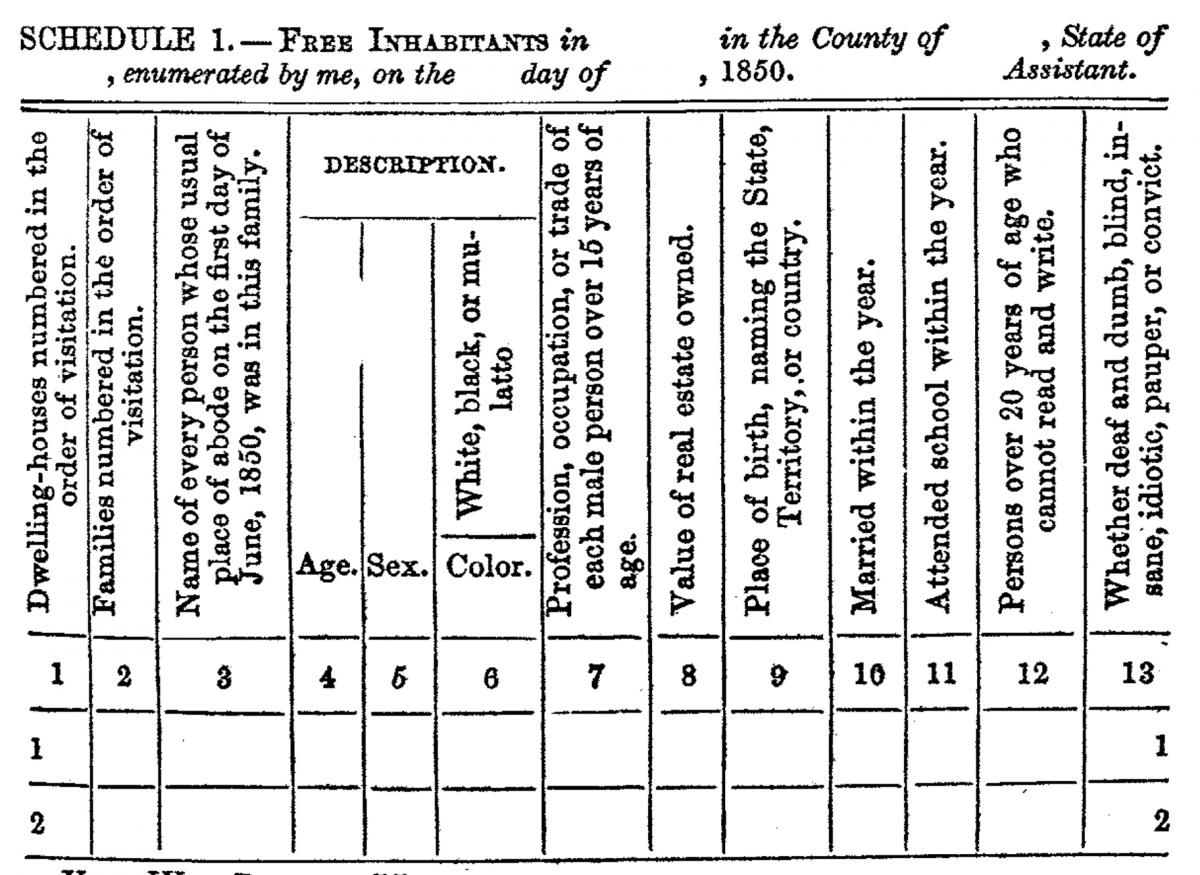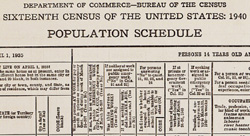
1860 Census Records
The 1860 population census was the Eighth Decennial Census of the United States. Taken every 10 years since 1790, census records provide a snapshot of the nation's population.
Frequently Asked Questions About the 1860 Census
Why was the 1860 Census taken?
Article I, Section 2, of the U.S. Constitution established that representation in the U.S. House of Representatives was based on population determined by a census taken at 10 year intervals: "The actual Enumeration shall be made within three Years after the first Meeting of the Congress of the United States, and within every subsequent Term of ten Years, in such Manner as they [Congress] shall by Law Direct."
What was the official census day?
Friday, June 1, 1860.
When was it taken?
The census began on Friday, June 1, 1860, and was finished within 5 months, under the rules and directions established in an Act of Congress approved ten years earlier on May 23, 1850 (“An Act providing for the taking of the seventh and subsequent Censuses of the United States....,” 9 Statutes at Large 428).
Who was counted?
The law required "all the inhabitants" of each Federal judicial district or territory be enumerated. The Instructions to Marshals and Assistants explained that the the term "usual place of abode" used in column 3 of Schedule 1, Free Inhabitants, meant the "the house or usual lodging place of a person" and that a person "temporarily absent on a journey, or for other purposes, without taking up his place of residence elsewhere, and with the intention of returning again, is to be considered a member of the family...."
Who was involved?
- Secretary of the Interior Jacob Thompson (1857-61), Caleb B. Smith (1861-62), and John P. Usher (1862-65) had general supervision of census operations, tabulation, and reporting the results to the President and Congress.
- Superintendent of the Census Joseph C. G. Kennedy submitted The Preliminary Report on the Eighth Census, 1860 (Washington: Government Printing Office, 1862) to Secretary Smith, and the final statistical population report, Population of the United States in 1860; Compiled from the Original Returns of the Eighth Census.... (Washington: Government Printing Office, 1864), to Secretary Usher.
- The U.S. Marshal for each Federal judicial district was responsible for taking the census in his district with the help of assistant marshals whom he appointed. Each took an oath or affirmation that "I will to the best of my ability enumerate, or cause to be enumerated, all the inhabitants of said district ... and will faithfully perform all the duties enjoined on me...." Each assistant marshal took an oath or affirmation that "I will make a true and exact enumeration of all the inhabitants within the district assigned to me, ... and will make due and correct returns thereof..." The act also specified "That each assistant ... shall perform the service required of him, by a personal visit to each dwelling-house, and to each family...." After the information was entered on the forms, "such memoranda shall be immediately read to the person or persons furnishing the facts, to correct errors and supply omissions, if any shall exist."
- Every person over age 20 was required to cooperate: "That each and every free person more than twenty years of age, belonging to any family ..., and in case of the absence of the heads and other members of any such family, then any agent of such family shall be and each of them hereby is, required, if thereto requested by the marshal or his assistant, to render a true account, to the best of his or her knowledge, of every person belonging to such family ... on pain of forfeiting thirty dollars...."
What questions did the census ask?
- Schedule 1 - Free Inhabitants
- Dwelling-house numbered in the order of visitation
- Families numbered in the order of visitation
- Name of every person whose usual place of abode on the first day of June, 1860, was in this family
- Age
- Sex
- Color (white, black, or mulatto)
- Profession, occupation, or trade of each person, male and female, over 15 years of age
- Value of real estate owned
- Value of personal estate owned
- Place of birth, naming the State, Territory, or Country
- Married within the year [hash mark if yes]
- Attended school within the year [hash mark if yes]
- Persons over 20 years of age who cannot read and write [hash mark if yes]
- Whether deaf and dumb, blind, insane, idiotic, pauper, or convict [hash mark if yes]
- Schedule 2 - Slave Inhabitants
- Name of slave owner
- Number of slaves
- Age
- Sex
- Color
- Fugitive from the state [hash mark if yes]
- Number manumitted
- Deaf and dumb, blind, insane, or idiotic
- Number of slave houses
What did the census form look like?
The Federal Government provided blank printed forms to the U.S. Marshals. There may be annotations such as certificates of oaths taken, population totals, and handwritten and mechanically-stamped page numbers. On March 3, 1849, Congress delegated decisions about the questions to be asked on the census to the "Census Board" whose members were the Secretary of State, Attorney General, and Postmaster General. ("An Act to make Arrangements for taking the seventh Census," 9 Statutes at Large 402). Their decisions resulted in the forms shown below.
What states and territories are included in the census?
Surviving population census records for free persons include census schedules for Alabama, Arkansas, California, Connecticut, Dakota Territory, Delaware, District of Columbia, Florida, Georgia, Illinois, Indiana, Iowa, Kansas Territory, Kentucky, Louisiana, Maine, Maryland, Massachusetts, Michigan, Minnesota, Mississippi, Missouri, Nebraska Territory, New Hampshire, New Jersey, New Mexico Territory, New York, North Carolina, Ohio, Oregon, Pennsylvania, Rhode Island, South Carolina, Tennessee, Texas, Utah Territory, Vermont, Virginia, Washington Territory, and Wisconsin. Special notes:
- Slave schedules exist for Alabama, Arkansas, Delaware, District of Columbia, Florida, Georgia, Kentucky, Louisiana, Maryland, Mississippi, Missouri, North Carolina, South Carolina, Tennessee, Texas, Utah, and Virginia.
- Dakota Territory - Fort Union and Fort Alexander (present day Montana) were in Nebraska Territory but were enumerated with Dakota Territory.
- Indian Territory - White, black, and mulatto persons on "Indian Lands" (Creek Nation, Cherokee Nation, Chickasaw Nation, Choctaw Nation, and Seminole Country) who were not Native Americans were enumerated as part of Arkansas.
- Nevada - Elko County: See schedules for Saint Mary's County, Utah.
- Nevada - Douglas, Lyon, Ormsby, and Storey Counties: See schedules for Carson County, Utah.
- West Virginia was part of Virginia.
Are some 1860 census records missing?
Yes. There are no schedules for:
- Florida - Hernando County, where no census was taken
- Louisiana - Bienville Parish
- Mississippi - Hancock, Sunflower, Tallahatchie, and Washington Counties
- Texas - Blanco County
It is possible that individual census pages for other locations were lost before they were bound in volumes in the early 1900s.
Where can I see the original 1860 census schedules?
Digital images of National Archives Microfilm Publication M653, Eighth Census of the United States, 1860 (1,438 rolls), are on popular genealogy websites, including Ancestry.com, FamilySearch.org, and others.





